We provide proper equipment for installation of irrigation systems in projects such as greenhouses, farms and golf courses. Our irrigation systems are designed to efficiently irrigate plants, with minimal water loss as a result of evapotranspiration. Our irrigation systems are cost-saving in the long run. They can be entirely buried, sub-surface buried or even fully exposed on the surface.
At Grekkon Limited, we pride ourselves by being leaders in supply and installation drip irrigation kits in Kenya. Our kits are affordable and last long.
Irrigation Systems Supplier In Kenya
What is the cost of drip irrigation kits in Kenya?
| Acreage | Size in Meters Square | Price in KES |
| Kadogo drip kit | 50 to 200 | KES 5,500 – KES 9,850 |
| 1/8th acre | 506 | KES 17,500 |
| 1/4 acre | 1,024 | KES 33,000 |
| 1/2 acre | 2,025 | KES 65,000 |
| 3/4 acre | 3,036 | KES 80,000 |
| 1 acre | 4,048 | KES 135,000 |
These are prices for 2 drip rows per bed
Our drip irrigation irrigation systems come with:
- Water filter to prevent emitter clogging
- Piping system
- Control valves
- Driplines
- Fittings and accessories
- A venturi fertigation system (optional)
Apart from the above drip kits, we make custom made designs based on your farm. For such kind of farms, we will do a survey and give appropriate designs. The above kits can either have two, three or four driplines per bed. Crops such as tomatoes, sweetpepper, brassicas prefer two driplines per bed while for onions, we recommend three or four driplines per bed. We stock high quality 16mm driplines with emmiter spacing of 15cm, 20cm and 30cm with single or double emitter spacing.
Irrigation Systems In Kenya
1. Drip irrigation system
Drip irrigation means timely application of water to the plant root zone, thereby saving water, time and energy while maximizing your yield. Farmers can use drip irrigation to irrigate their vegetables, fruit trees such as bananas, avocadoes, passion fruits, maize e.t.c. Crops under drip irrigation mature faster, are uniform and of top quality. Farmers also save on labour costs as compared with other methods of irrigation.

Vegetable Drip Irrigation
This is a flexible system and can be wound through flower beds or borders, around trees or shrubs, run down rows or raised vegetable beds and can be used in container planting. It is an inexpensive and effective method for watering a variety of plants and gardens.
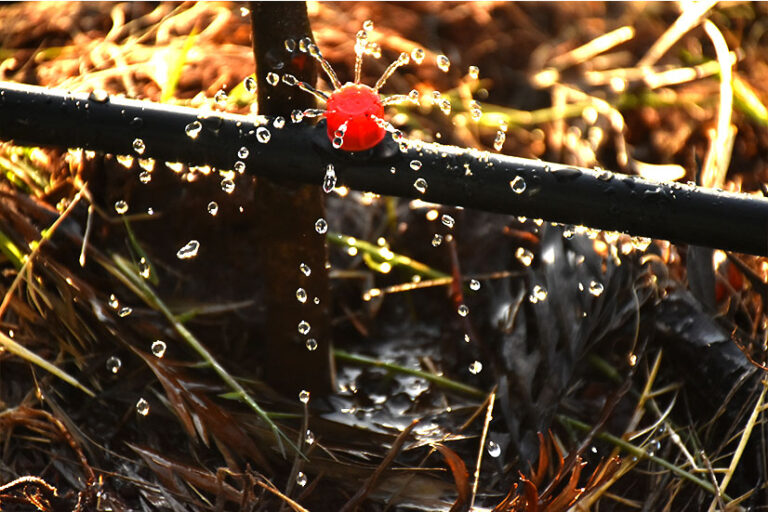
Drip irrigation for mangoes, passion fruits, avocadoes and other fruit trees
We use button drippers, micro sprinklers, or 1mm thick drip lines to irrigate passion fruits, avocadoes, coffee, macademia and other fruit trees. This is because these trees are widely spaced. The drippers and micro sprinklers are placed at the crop’s root area, ensuring no wastage of water and nutrients
The drippers are either the adjustable type, emitting 0-70L per hour or pressure compensated, which can either emit 4L, 8L or 16L per hour.
Irrigation Systems In Kenya
2. Overhead irrigation irrigation systems
Since its inception, Grekkon Ltd has supplied quality and affordable sprinklers in Kenya for different applications. Our sprinklers are built to last long that can work either under gravity or pumps driven. Major use of our sprinklers include crop cultivation, lawn irrigation and dust suppression in construction sites
i. Impact sprinklers

Impact sprinklers are overhead irrigation accessories that water crop under moderate to high pressure. The moderate pressure power force is by gravity, and the higher pressure is from a water pump. These impact sprinklers in Kenya are in various inlet pipe diameter sizes as; 1/2 inch, 3/4 inch, and 1 inch.
Impact sprinklers prices
| Impact Sprinkler Head | Price in KES | |
| 1/2″ | KES 250 | |
| 3/4″ | KES 450 | |
| 1″ | KES 950 | |
How to use impact sprinklers
During irrigation, consider crops that are not susceptible to foliage fungal infections as a result of wetness on their leaves. Drip irrigate for tomato, peppers, potato, chili, and other solanaceous crops. This is to avoid excess moisture on their leaves because they quickly succumb to leaf fungal infections as a result of wetness. Certain bean types, snow-peas, and mangetout too will easily get leaf fungal infections under sprinklers. Common food crops such as; onion, cabbage, grass, and legume pastures. Others are; garlic, carrot, maize, lettuce, broccoli, cauliflower, watermelon, orchards, forestry crops. Many others will be fine under this irrigation system
ii. Raingun Sprinklers
Raingun sprinklers are a type of unique sprinklers that are able to irrigate large portions of land within a short period, saving you on time, energy and cost. Raingun sprinklers are able to irrigate from as low as 1/4 acre to as large as 2 acres in one rotation. Suitable crops to be irrigated by the big rain gun sprinklers include cabbages, onions, lawns and grass, golf courses, potatoes e.t.c. In construction sites, our clients use them for dust suppression.
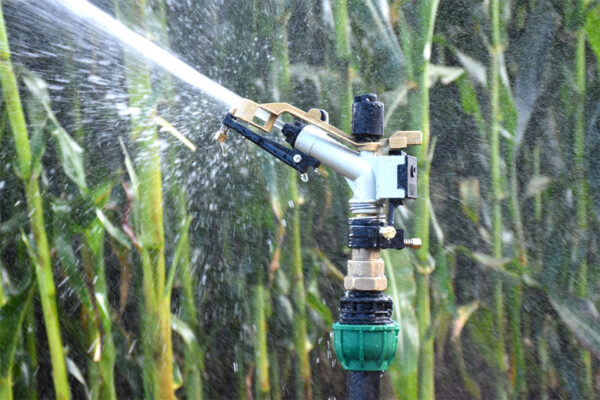
OTHER FEATURES:
– Metallic or plastic choice -Have shooting radius of 15m to 40m depending on size and pressure -Pressure ranges from 2-5 bar depending on size -Available size are 1’’ , 1½ ‘’ , 2’’ and 2 ½‘’ -Our rainguns are either impact or gear driven.
Note that they work well with high pressure pumps.
iii. Pop up sprinklers
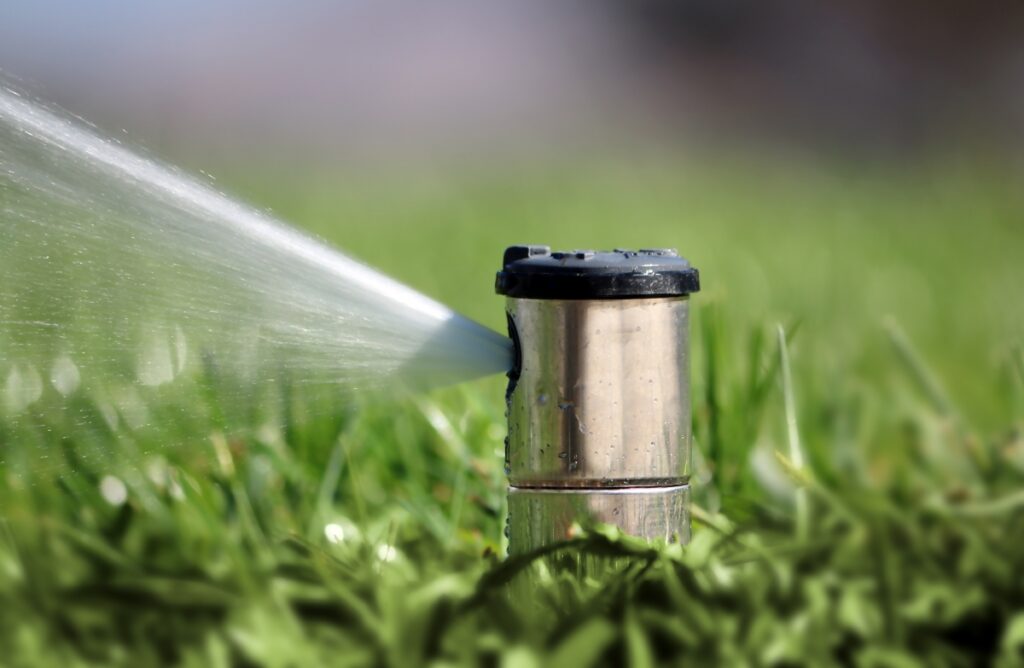
Pop-up sprinklers in Kenya are suitable for lawns, parks, golf courses, and gardens. Our lawn sprinklers irrigation systems are designed to distribute water evenly on lawns. We install this lawn sprinkler system in football fields, golf courses, and recreation parks. We train our clients on how to install pop-up lawn sprinklers for those who plan to do so themselves
Pop-up sprinkler price in Kenya
- 1/2″ Kes 2,750
- 3/4″ Kes 3,750
Types Of Pop -Up Sprinklers By Grekkon Limited
- Plastic models. The outer cover is plastic, and much of the internal body too. Some components such as the spring, and nozzles are metallic
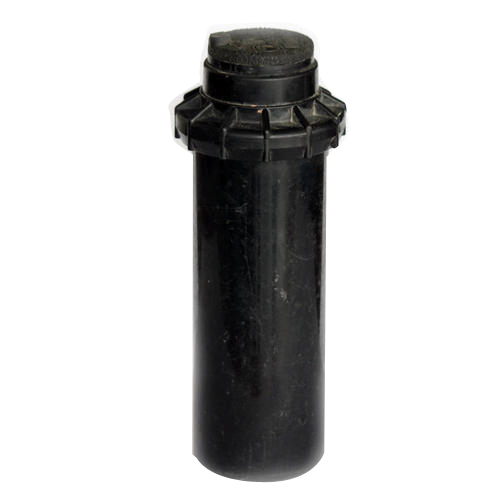
A plastic Rain bird pop-up sprinkler
Irrigation systems in Kenya
How pop-up sprinklers work
1. Design
They are built using raisers that are designed to rise up to irrigate 2 to 12 inches above ground under high water pressure. It has a built-in debris filter, and a robust gear drive which turns the sprinkler to the per-defined arc or radius of spraying required
2. Irrigation technique
Once the irrigation cycle is complete, decreasing water pressure causes the riser to retract back to its housing at ground level. Sprinkler heads will not pop up when clogged with debris or dirt. A leak in the water line can cause low water pressure and keep water from flowing to the sprinkler head, so it won’t pop up. Another reason when there is low water pressure in the sprinkler system cuts down the irrigation range and will even cause the sprinkler heads not to function at all
3. Installation of a pop-up sprinkler
During installation, we space the sprinklers 25 feet apart for the larger ones that irrigate a radius beyond 16 feet diameter. For those sprinklers that do a smaller area, we space at 12-15 feet apart. The system is powered by a high pressure, high volume electric pump
Pop up sprinkler installation is done from the edge of lawn towards the middle
4. Protection
A lawnmower cannot damage them in their retracted position because it’s protected. Our most common heights are 2,3,4,6 and 12 inches
5. Pop up sprinkler adjustment
Grekkon Limited’s pop up sprinklers are adjustable in 2 ways
- Adjustment for spray radius. You can reduce or increase the radius of spray. This will not have an impact on the volume of water discharged per unit of time. If you reduce it, then it means the same amount of water over a smaller area
- Adjustment for spraying degree. You can have your pop up sprinkler spray 10 degrees or 360 degrees. This depends on the location. For instance, if the house is behind the sprinkler, then it will be adjusted to a 180 degree of spray. if it is in the middle of the lawn, then this will be set to 360 degrees of spray
6. Pop up sprinkler irrigation systems
Consist of;
- An electric surface water pump. Ths size of the water pump is determined b the number of pop up sprinklers to be operated in one go
- A HDPE or PVC main and sub main line. This one delivers water from the source to the sprinkler
- HDPE or PVC fittings for use with the water pump
- Ball valves. These are to control water movement between the source and the pipes, and also between various block on the lawn
- Housing. This is where the pop up sprinkler rests. It protects it from soil or physical damage
- Pop up sprinklers. As per the area under irrigation, various sizes are used
- Pressure gauge. To assess the pressure along the line
- Cabling for the electric water pump to a power source. In an automated system, the cabling extends to the ball valves to control opening and closing
- A timer. In an automated system, the timer controls when to irrigate, and how long a block is irrigated before the system switches it off
- Sensors. These too are in automated systems to send signals that determine the timing and area of irrigation
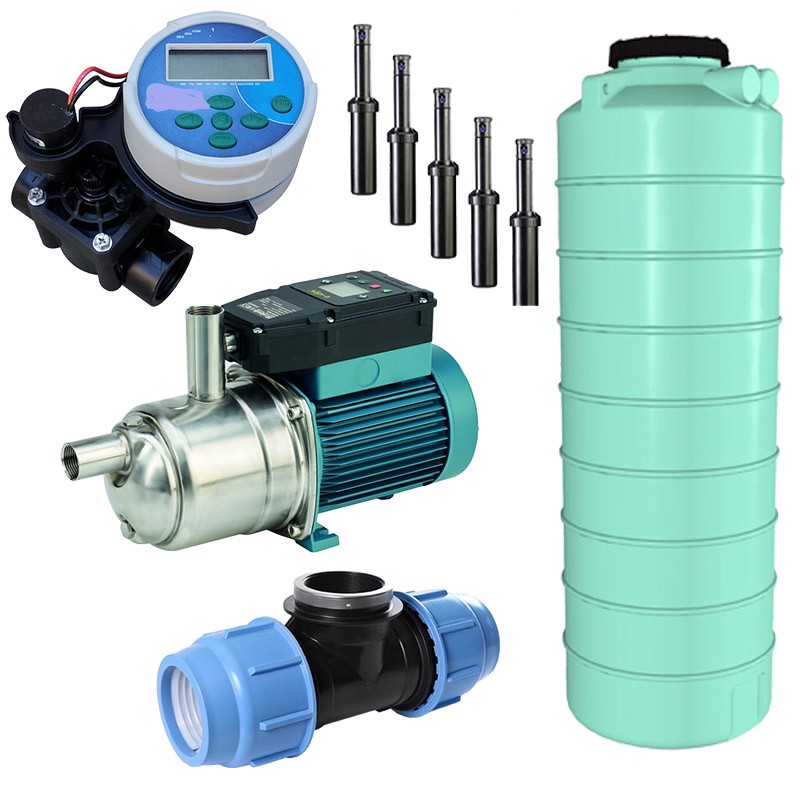
A sample pop up sprinkler kit
3. Rainhose irrigation systems
Rain hose systems are a new overhead way of watering crops intensely under moderate pressure. Each kit has a 100M long linear low density polyethylene (LLDPE) pipe as the main accessory. The rain pipe is sequentially perforated at determined intervals using Nanotechnology to create tiny holes from which crops are irrigated. This technology ensures even water flow from every hole
It is an overhead irrigation technology that works by spraying water on plants, an alternative to sprinkler irrigation system. The system is cost effective and effective. Rainhose irrigation system uses a flexible hose with a series of holes at pre-determined spacing. These holes are made using nano technology to ensure uniform distribution of water.
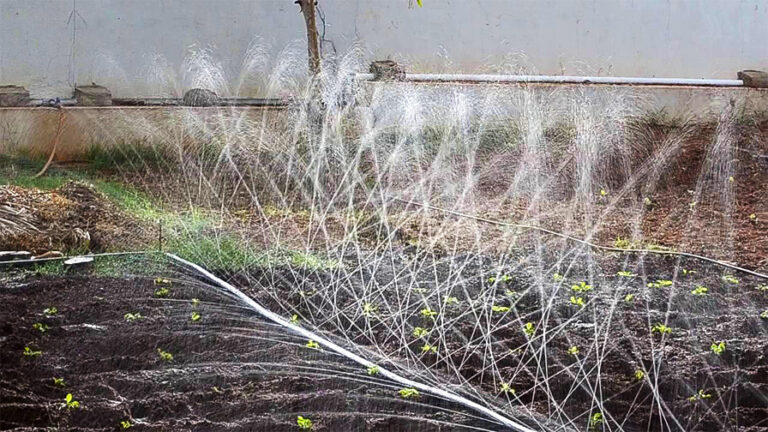
A rain hose irrigation systems in a commercial farm
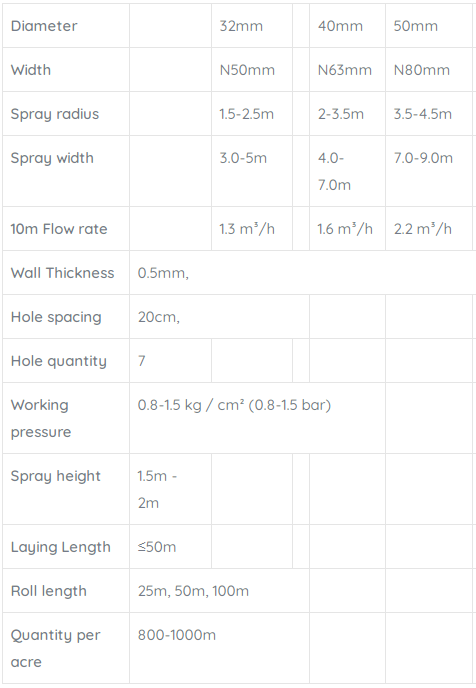
What is the price of a rain hose irrigation systems kit?
| Diameter size | Flow rate per 100M | Price in KES |
| 32mm or 1″ | 13 cubic litres per hour | KES 2,500 |
| 40mm or 1-1/4” | 16 cubic litres per hour | KES 5,800 |
| 50mm to 1-1/2″ | 22 cubic litres per hour | KES 6,800 |
Before installing a rain pipe irigation system in a farm, we conduct a site visit to assess:
- the water volume available
- crop acreage
- crop type
- land dimension
- farm topography and lay out
This is the information that guides us on the design of the irrigation system to set up. If the water volume for instance is low, we recommend a more water efficient method such as drip irrigation. Alternatively, we’ll advice on a water harvesting technique to increase the water volume
What are the other components of a rain hose irrigation systems kit?
1. End-caps. They close the end of the pipe to prevent further water flow
2. Starter off-takes. They connect the rain pipe to the PVC or HDPE main line that supplies water to the rain hose from a water pump or highly elevated water tank
3. Pipe connectors. To connect one rain hose pipe to another
4. Mini valves. To control water flow to the rain hose pipe
The diameter of the pipe are; 25mm, 32mm, 40mm and 50mm. A grower chooses the preferred size based on crop water needs and area of irrigation. For instance, a farmer with 1 acre of the crop will comfortably water with the volume delivered through a 32mm rain hose pipe.
Another grower with 5 acres will better irrigate with a 50mm rain hose pipe. An acre of crop uses 1,000 meters of 25mm, 800 meters of 32mm rain hose pipes, 600M of 40mm pipes, and 400M of 50mm pipes
Irrigation Systems In Kenya
Rain pipe irrigation system requirements
- The system requires a pressure head of 30M, and above
- When using a water pump to power the rain hose irrigation kit, the discharge rate should be from 45 cubic litres per hour
- The rate of water discharge is determined by the diameter size, and number of pores on the rain pipe. For instance, a rain pipe with 5 holes per cluster discharges less water than the one with 7 holes in a cluster
- It irrigates in opposite directions at a radius of 3M for the 32mm pipe, 5M for the 40mm pipe, and 7M for the 50mm pipe
- The vertical height of this water jet is 1M
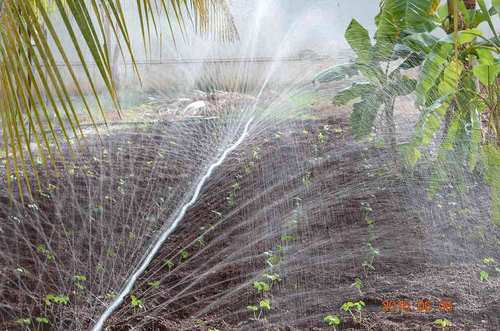
A rain hose pipe on a young crop


